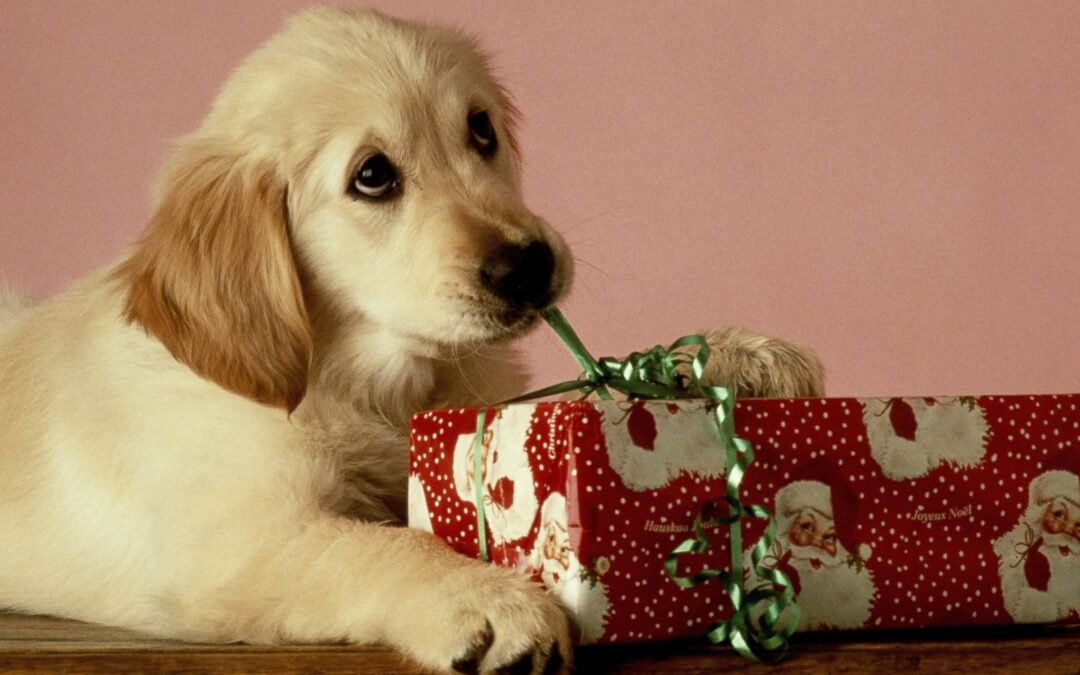
The holidays are a special time for everyone, even for our fur babies. The lights, the sparkles, the smells of yummy things. Like the song says: “It’s the most wonderful time of the year.” However, Christmas can also be one of the most dangerous times for your pets. So the friendly folks at the Humane Society of the Nature Coast would like to offer these six tips to keep your fur babies safe this Christmas.
1) The Christmas Tree
With all those lights and dangley-sparkley things, a Christmas Tree can be a source of curiosity, excitement and danger for your fur babies. Dogs and cats are notorious for using ornaments as toys, chewing on light strands and trying to jump onto — or even into – a Christmas Tree.
- Make sure you anchor your tree with a secure, stable tree stand, and check the bolts holding the tree to the stand daily to make sure they remain tight to hold the tree in place.
- Make sure the ornaments on the lower part of the tree are pet friendly (more on that later). Avoid edible ornaments (candy canes, popcorn/cranberry strands, gingerbread cookies, etc.) and place any ornaments that look like pet toys higher on the tree to avoid temptation.
- Tinsel is incredibly dangerous to both dogs and cats. While the animal starts out playing with the shiny tinsel, which shimmers and moves with the lightest touch, this exploration inevitably involves the mouth. For some, it will head down the “wrong pipe”—causing them to choke and cough. With luck, they will cough it up and out, eliminating the problem. But if the tinsel is actually swallowed it can lodge in the throat and cut off the air supply. If it heads all the way down into the intestinal tract, it can all sorts of internal problems.
- Make sure light strands and electrical cords are secure and out of the tempting view of your pets. Consider using a protective covering such as The Chewsafe cord protector or the CritterCord to prevent the teeth of curious or mischievous pets from sinking in.
- Fur Parents who prefer fresh cut Christmas Trees need to ensure that the water reservoir of the tree stand is covered to make sure your fur babies don’t use it for a water bowl. As the tree hydrates, it can release toxic sap into the water trough, which will smell tasty to your pets. Many fresh trees are also preserved with pesticides and fertilizer water additives, including aspirin. Aspirin can be fatal for cats because they lack a necessary protein in their livers to break down the drug. While veterinarians occasionally prescribe aspirin for dogs to treat various conditions, too much can prove deadly.
2) Ornaments
While ornaments are beautiful, they can pose potential choking or cutting hazards for your curious fur babes so it’s important to keep your fur babies safe this Christmas. Cats and dogs are inherently curious and the first thing on their minds when they see something new is… “what does that taste like?” Ornaments they chew on can break and the swallowed parts can wind up blocking – or even cutting – the throat, the stomach or the intestinal tract. Glass ornaments can be particularly dangerous if they fall – or are batted – from the tree and break, they can cut your pets mouth, their paws or even somewhere internally if swallowed.
3) Poisonous Plants

Another way to keep your fur babies safe this Christmas is to pay attention to the plants you have in the house during the holidays. Poinsettia, holly, mistletoe are popular and quite beautiful Christmas plants. However, they can be dangerous to your pet’s health if ingested.
The poinsettia flower is typically only toxic when ingested in large quantities, so its reputation as the most dangerous Christmas plant is somewhat undeserved. That said, the milky white sap of the poinsettia tends to cause diarrhea, excessive drooling, and vomiting.
English and Asian varieties of the holly plant contain toxic saponins, which can cause serious gastrointestinal distress when eaten.
The viscotoxins in mistletoe are nothing to kiss over; eating the leaves or berries of this common Christmas plant can cause stomach upset and a slowed heartbeat.
Christmas bouquets and floral arrangements that contain lilies are very hazardous to pets, especially cats. All it takes is a few bites of a lily plant to cause potentially fatal kidney failure in felines.
If your pet ingests pine needles, they could cause serious gastrointestinal problems. Ingesting them can cause vomiting and depression. The tree needles are capable of triggering digestive blocks and puncturing the intestines. Fake Christmas tree needles are just as dangerous as a chocking hazard or something to cause an intestinal blockage. Pine cones can cut your pets mouth or become lodged in their throats. They can also cause intestinal blockages. Fallen dried Christmas Tree needles can stick into your pets paws and mouth like a painful splinter, which could become infected.
4) Stockings, Wrapped Gifts and Candy Bowls
Wrapped gifts can be so beautiful… and tempting for any pet looking for a new chew toy. So it’s important to make sure these items are out of reach to keep your fur babies safe this Christmas. Believe it or not, chlorine bleach and toxic dyes are sometimes used to create those colorful patterns on wrapping paper. Gift-wrapping involves more than just paper and boxes, though. Tape, ribbons and bows can be chewed and swallowed by an unsupervised pet, which can lead to intestinal blockages and rupture.
Additional caution should be taken to make sure batteries are unavailable as chew toys. A ruptured battery can cause chemical burns and threaten your pet’s life.
Stocking stuffers can pose a health hazard for your fur babies as well. Small toys and candies can become choking hazards or a bowel blockage. Chocolate can be deadly if consumed in large enough quantities.
5) Candles
Who doesn’t enjoy the festive glow of a candle, especially during the holidays? But an unguarded open flame can become a fire hazard, particularly when you have pets. Cat’s a notorious for climbing to high places and an open candle flame can easily burn your cat as they don’t always pay attention to where their tails are. Cats are also known for pushing everything they can find from a horizontal surface. How many times have you seen a coffee table cleared of items by the swoosh of a happy dog’s tail? Candles can be knocked over. Nearby decorations can be bumped and batted toward the flame and catch fire and those can fall into other flammable things and the next thing you know, chestnuts won’t be the only thing roasting in an open fire.
Make sure you are aware of where burning candles are sitting and that your pets aren’t in the area.
1) BE PREPARED!
Have your veterinarian’s phone number and the number of an emergency veterinarian on hand and know the location of the one closest to you, particularly those that are open after hours!
The 24-hour ASPCA emergency poison hotline at 1-888-426-4435 if you have any concerns about potentially harmful substances ingested by your pet. Specialists are available to aid you every day of the year, including Christmas.
What steps are you taking to keep your pets safe this Christmas? Do you have any other tips for pet parents? Let us know in the comments below!







